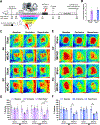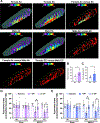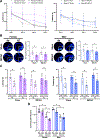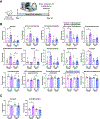Electronic Cigarette Vape Exposure Exacerbates Post-Ischemic Outcomes in Female but Not in Male Rats
- PMID: 38323450
- PMCID: PMC10940219
- DOI: 10.1161/STROKEAHA.123.046101
Electronic Cigarette Vape Exposure Exacerbates Post-Ischemic Outcomes in Female but Not in Male Rats
Abstract
Background: Nicotine-containing electronic cigarette (EC) vaping has become popular worldwide, and our understanding of the effects of vaping on stroke outcomes is elusive. Using a rat model of transient middle cerebral artery occlusion, the current exploratory study aims to evaluate the sex-dependent effects of EC exposure on brain energy metabolism and stroke outcomes.
Methods: Adult Sprague-Dawley rats of both sexes were randomly assigned to air/EC vapor (5% nicotine Juul pods) exposure for 16 nights, followed by randomization into 3 cohorts. The first cohort underwent exposure to air/EC preceding randomization to transient middle cerebral artery occlusion (90 minutes) or sham surgery, followed by survival for 21 days. During the survival period, rats underwent sensorimotor and Morris water maze testing. Subsequently, brains were collected for histopathology. A second cohort was exposed to air/EC after which brains were collected for unbiased metabolomics analysis. The third cohort of animals was exposed to air/EC and received transient middle cerebral artery occlusion/sham surgery, and brain tissue was collected 24 hours later for biochemical analysis.
Results: In females, EC significantly increased (P<0.05) infarct volumes by 94% as compared with air-exposed rats, 165±50 mm3 in EC-exposed rats, and 85±29 mm3 in air-exposed rats, respectively, while in males such a difference was not apparent. Morris water maze data showed significant deficits in spatial learning and working memory in the EC sham or transient middle cerebral artery occlusion groups compared with the respective air groups in rats of both sexes (P<0.05). Thirty-two metabolites of carbohydrate, glycolysis, tricarboxylic acid cycle, and lipid metabolism were significantly altered (P≤0.05) due to EC, 23 of which were specific for females. Steady-state protein levels of hexokinase significantly decreased (P<0.05) in EC-exposed females; however, these changes were not seen in males.
Conclusions: Even brief EC exposure over 2 weeks impacts brain energy metabolism, exacerbates infarction, and worsens poststroke cognitive deficits in working memory more in female than male rats.
Keywords: Morris water maze test; electronic nicotine delivery systems; glycolysis; icotine; vaping.
Conflict of interest statement
Figures






Similar articles
-
Exposure to electronic cigarette vapor exacerbates ischemic loss of tryptophan/tyrosine hydroxylase-positive neurons in the rat brain.Exp Neurol. 2025 Aug 7;393:115416. doi: 10.1016/j.expneurol.2025.115416. Online ahead of print. Exp Neurol. 2025. PMID: 40782938
-
Electronic cigarettes for smoking cessation.Cochrane Database Syst Rev. 2022 Nov 17;11(11):CD010216. doi: 10.1002/14651858.CD010216.pub7. Cochrane Database Syst Rev. 2022. Update in: Cochrane Database Syst Rev. 2024 Jan 8;1:CD010216. doi: 10.1002/14651858.CD010216.pub8. PMID: 36384212 Free PMC article. Updated.
-
Electronic cigarettes for smoking cessation.Cochrane Database Syst Rev. 2021 Sep 14;9(9):CD010216. doi: 10.1002/14651858.CD010216.pub6. Cochrane Database Syst Rev. 2021. Update in: Cochrane Database Syst Rev. 2022 Nov 17;11:CD010216. doi: 10.1002/14651858.CD010216.pub7. PMID: 34519354 Free PMC article. Updated.
-
Pharmacological and electronic cigarette interventions for smoking cessation in adults: component network meta-analyses.Cochrane Database Syst Rev. 2023 Sep 12;9(9):CD015226. doi: 10.1002/14651858.CD015226.pub2. Cochrane Database Syst Rev. 2023. PMID: 37696529 Free PMC article.
-
Interventions to reduce harm from continued tobacco use.Cochrane Database Syst Rev. 2016 Oct 13;10(10):CD005231. doi: 10.1002/14651858.CD005231.pub3. Cochrane Database Syst Rev. 2016. PMID: 27734465 Free PMC article.
Cited by
-
Menstruation: An Important Indicator for Assessing Stroke Risk and Its Outcomes.Stroke. 2025 Feb;56(2):533-542. doi: 10.1161/STROKEAHA.124.048869. Epub 2024 Nov 7. Stroke. 2025. PMID: 39508108 Review.
References
-
- Rose JJ, Krishnan-Sarin S, Exil VJ, Hamburg NM, Fetterman JL, Ichinose F, Perez-Pinzon MA, Rezk-Hanna M, Williamson E, American Heart Association Council on Cardiopulmonary CCP, et al. Cardiopulmonary Impact of Electronic Cigarettes and Vaping Products: A Scientific Statement From the American Heart Association. Circulation 2023. doi: 10.1161/CIR.0000000000001160 - DOI - PubMed
Publication types
MeSH terms
Substances
Grants and funding
LinkOut - more resources
Full Text Sources
Medical

